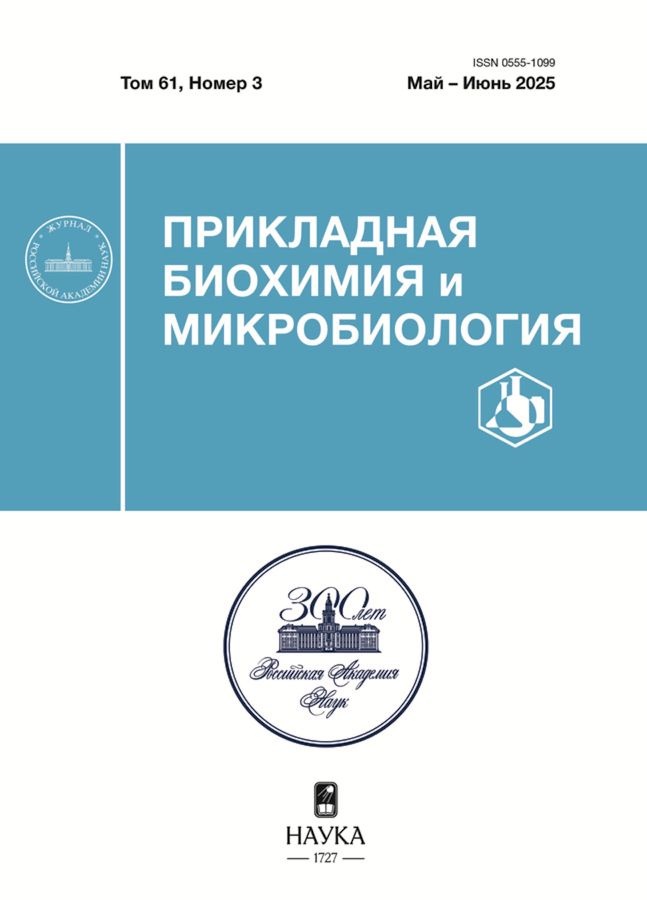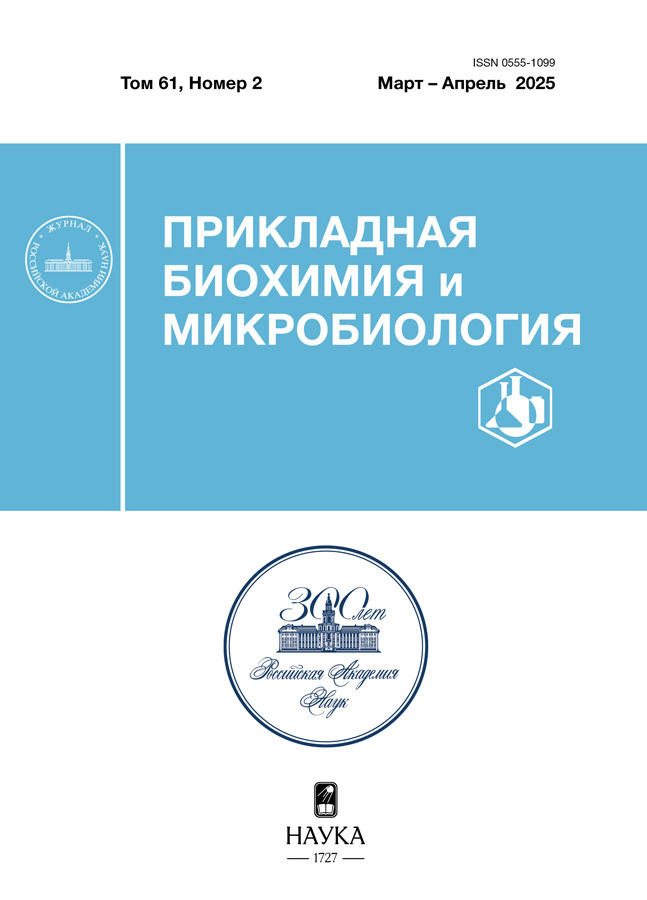Respiratory activity and biosynthesis of alkaloids by the fungus Penicillium citrinum Thom
- Authors: Arinbasarova А.Y.1, Antipova T.V.1, Zhelifonova V.P.1, Medentsev A.G.1
-
Affiliations:
- FRC Pushchino Centre for Biological Research, Russian Academy of Sciences
- Issue: Vol 61, No 2 (2025)
- Pages: 156-161
- Section: Articles
- URL: https://hum-ecol.ru/0555-1099/article/view/687496
- DOI: https://doi.org/10.31857/S0555109925020058
- EDN: https://elibrary.ru/EOHLYH
- ID: 687496
Cite item
Abstract
The fungus Penicillium citrinum VKM F-4043D isolated from ancient permafrost deposits in the Arctic is an active producer of quinoline alkaloids (quinocitrinines A and B) and clavine ergot alkaloids (agroclavine-I and epoxyagroclavine-I). During fungal growth in a medium with two non-fermentable substrates — succinate and mannitol, the dynamics of respiratory activity was studied. Oxygen consumption by cells was shown to be associated with the dynamics of two-phase synthesis of biomass and alkaloids, the maximum respiratory activity had been coincided with the maximum rates of alkaloid synthesis and biomass accumulation. As shown by inhibitory analysis of fungal respiration, along with the main, cytochrome, respiratory chain, an alternative, cyanide-resistant, electron transfer pathway functions, which is suppressed by benzhydroxamic acid. It has been shown that the fungus P. citrinum is capable of growing in the presence of antimycin A, an inhibitor of electron transfer in the cytochrome region of the respiratory chain. In this case, the alternative oxidase functions as the only terminal oxidase capable of supporting fungal growth and alkaloid biosynthesis. When glucose was used as a growth substrate, biosynthesis of both alkaloids and cyanide-resistant oxidase was not observed.
Full Text
About the authors
А. Yu. Arinbasarova
FRC Pushchino Centre for Biological Research, Russian Academy of Sciences
Author for correspondence.
Email: aarin@rambler.ru
Skryabin Institute of Biochemistry and Physiology of Microorganisms
Russian Federation, Pushchino, 142290T. V. Antipova
FRC Pushchino Centre for Biological Research, Russian Academy of Sciences
Email: aarin@rambler.ru
Skryabin Institute of Biochemistry and Physiology of Microorganisms
Russian Federation, Pushchino, 142290V. P. Zhelifonova
FRC Pushchino Centre for Biological Research, Russian Academy of Sciences
Email: aarin@rambler.ru
Skryabin Institute of Biochemistry and Physiology of Microorganisms
Russian Federation, Pushchino, 142290A. G. Medentsev
FRC Pushchino Centre for Biological Research, Russian Academy of Sciences
Email: aarin@rambler.ru
Skryabin Institute of Biochemistry and Physiology of Microorganisms
Russian Federation, Pushchino, 142290References
- Chen W.H., Song M.M., Pang X.Y., Tian X.P., Wang F.Z., Liu Y.H., Wang J.F. // Nat. Prod. Res. 2023. V. 37. № 3. P. 389–396.
- Kozlovsky A.G., Kochkina G.A., Zhelifonova V.P., Antipova Т.V., Ivanushkina N.E., Ozerskaya S.M. // Folia Microbiol. 2020. V. 65. P. 95–102.
- Frisvad J.C., Smedsgaard J., Larsen T.O., Samson R.A. // Studies in Mycology. 2004. V. 49. P. 201–241.
- Козловский А.Г., Антипова Т.В., Желифонова В.П. // Прикл. биохимия и микроб. 2015. Т. 51. № 2. С. 236–241.
- Pang X., Lin X., Zhou X., Yang B., Tian X., Wang J., Xu Sh., Liu Y. // Fitoterapia. 2020. V. 140. P. 104406.
- Jian J.Y., Fan Y.M., Liu Q., Jin J., Yuan C.M., Gu W. et al. // Chem Biodivers. 2023. V. 20. № 2. P. e202201097.
- Khan M.S., Gao J., Zhang M., Xue J., Zhang X. // PLoS One. 2022. V. 17. № 6. P. e0269640.
- da Silva M.F.d.G.F., Fernandes J.B., Forim M.R., Vieira P.C., de Sá I.C.G. Natural Products. / Ed. K. Ramawat, J.M. Mérillon, JM. Berlin, Heidelberg: Springer, 2013. P. 715–859.
- Thawabteh A., Juma S., Bader M., Karaman D., Scrano L., Bufo S.A., Karaman R. // Toxins. 2019. V. 11. № 11. P. 656.
- Takahashi S., Kakinuma N., Iwai H., Yanagisawa T., Nagai K., Suzuki K. et al. // J. Antibiot. (Tokyo). 2000. V. 53. № 11. P. 1252–1256.
- Shahid M.G., Nadeem M., Gulzar A., Saleem M., Rehman H.U., Ghafoor G.Z. et al. // Toxins. 2020. V. 12. № 7. P. 427. https://doi.org/10.3390/toxins12070427
- Козловский А.Г., Желифонова В.П., Аданин В.М., Озерская С.М., Кочкина Г.А., Грефе У. // Микробиология. 2003. Т. 72. № 6. С. 816–821.
- Kozlovsky A.G., Zhelifonova V.P., Antipova T.V., Adanin V.M., Ozerskaya S.M., Kochkina G.A. et al. // J. Antibiot (Tokyo). 2003. V. 56. № 5. P. 488–491.
- Патент РФ 2010. № 2386692.
- Аринбасарова А.Ю. Меденцев А.Г., Козловский А.Г. // Прикл. биохимия и микроб. 2007. Т. 43. № 6. С. 701–704.
- Акименко В.К., Козловский А.Г., Меденцев А.Г., Головченко Н.П., Аринбасаров М.У. // Биохимия. 1976. T. 41. № 12. P. 2220–2227.
- Меденцев А.Г., Аринбасарова А.Ю., Акименко В.К. // Биохимия. 1999. T. 64. C. 1457–1472.
- Козловский А.Г., Желифонова В.П., Антипова Т.В., Зеленкова Н.Ф. // Прикл. биохимия и микробиология. 2010. Т. 46. № 5. С. 572–576.
- Перт С.Д. Основы культивирования микроорганизмов и клеток. М.: Мир, 1978. 331 c.
- Козловский А.Г., Желифонова В.П., Антипова Т.В. // Прикл. биохимия и микроб. 2013. Т. 49. № 1. С. 5–16.
Supplementary files














